13 November, 2004
Hard work, lot’s of fun!
Temperature: 5* F in am, 19 * F in pm
Location: Lake Hoare
Field work requires lots of effort and lots of teamwork. Scientists work
awfully hard out in the field. Tasks that sound like they should be quite
simple are much more difficult to accomplish in remote locations. It is
humbling to see so many scientists working so hard to learn about our world. I
am privileged to be able to help in the process.
First thing this morning, we went out to the dive hole to check on the melting
progress. It is forming nicely; we hope to be diving on Monday! We still have
the heating coil down the hole to increase the diameter of the hole. The hole
is also coming close to the auger that is frozen into the ice. Ian and I set
up a couple ice screws to guide the heating coil to the most desirable position
for expedient melting. The edges of the hole are beautiful; I am anxious to
get in and see it from below!
While we wait for the dive hole to finish melting, there is plenty of other work
to be done. We measured the water level of the lake. This information gives
the scientists some insight into what the climate conditions were like through
the year. Higher lake levels mean warmer conditions, thus more melting off the
glacier. The melt water flows into the lake, raising the water level.
Likewise, lower lake levels indicate cooler conditions. We used the surveying
equipment to measure the lake water level. First we had to drill a hole to
allow the water level to expose itself!
To compliment this data, we also went to various locations throughout the lake
and measured the ablation rate of the ice. The ice ablates, or is removed,
from the surface of the lake. Several years ago, Peter put several ablation
stakes into the lake. These are poles that stick up from the surface of the
ice and extend through the ice into the lake. The poles are frozen into the
lake. As the ice ablates off the top and refreezes on the bottom, the poles
are moved upward. Each year Peter measures how much of the poles are exposed
compared to the previous year. This year there is a three foot addition to the
amount of exposed poles; that is impressive!
As we retired for the evening, at 11:30 pm, we refilled the fuel in the
generators and hotsy’s so they would burn through the night. The “stuck” auger
is almost free! The dive hole looks quite inviting!
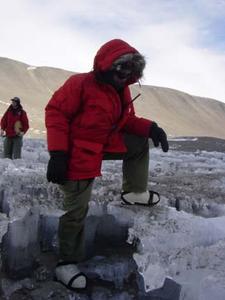
1. Jackie showing the variations within the lake ice. It is quite challenging walking across the ice; occasionally, you fall through the higher levels to the lower level. There is no worry of falling through the ice into the water, it’s 15 feet thick, but it sure hurts to punch through and bang your knees!
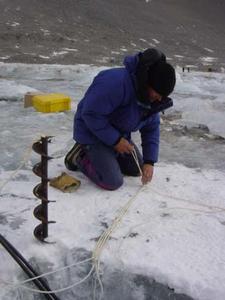
2. Ian secures a rope to an ice screw in order to pull the hot finger in the proper direction to melt the dive hole. Notice the auger which is frozen into the ice.
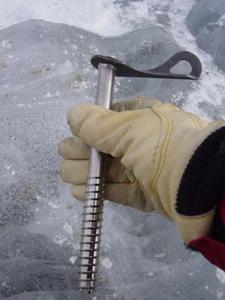
3. An ice screw used to secure a variety of items.
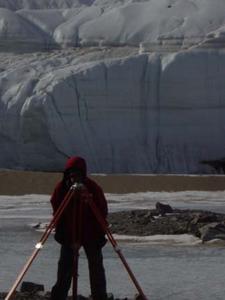
4. Brandy peers through the surveying scope to determine lake water level.
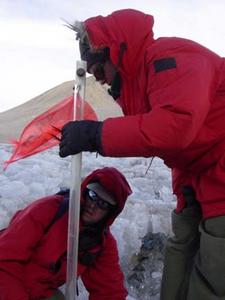
5. Peter and Jackie check the ablation stake.
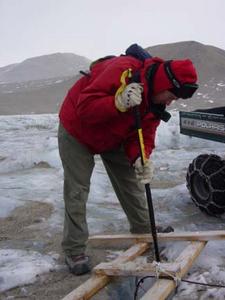
6. Peter chips out some ice from one of the holes.
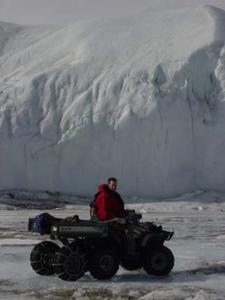
7. Peter in front of the Canada Glacier.
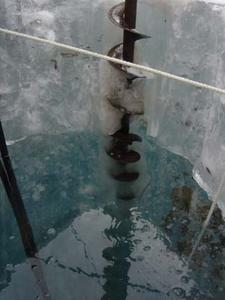
8. The beginning of the dive hole; notice the stuck auger is now almost free!
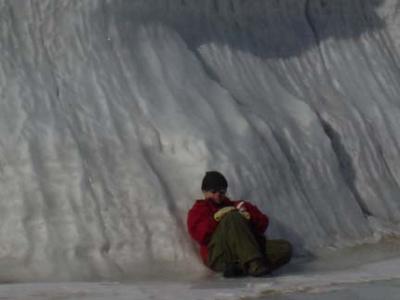
9. Me taking a quick rest in a comfy nook of the Canada Glacier.
Contact the TEA in the field at
.
If you cannot connect through your browser, copy the
TEA's e-mail address in the "To:" line of
your favorite e-mail package.
|
